A forensic examination of the door…
Don’t open that door!
To open and to close doors is so deeply part of our routine that we don’t even have to think about it, we just do it… unless the keys are lost somewhere, at the bottom of the bag or, worse, forgotten right behind that door that you have just closed, and you wish you could re-open now!
To open and to close are almost unconsciously driven acts. However, in order to be enabled to do so a conscious and deep level of design is required to allow the technical control: without the necessary skill and an accurate design, that unconscious act, would suddenly become too conscious.
The proper discreet working of doors depends on the proper working of each single organ comprising its complex body, but there are three elements without which a door wouldn’t really do its job.
The joints: hinges.
A door could work somehow, even if partially, without a handle or the lock, but hinges are vital organs: a door wouldn’t be a door without hinges (I am leaving out sliding doors of course!).
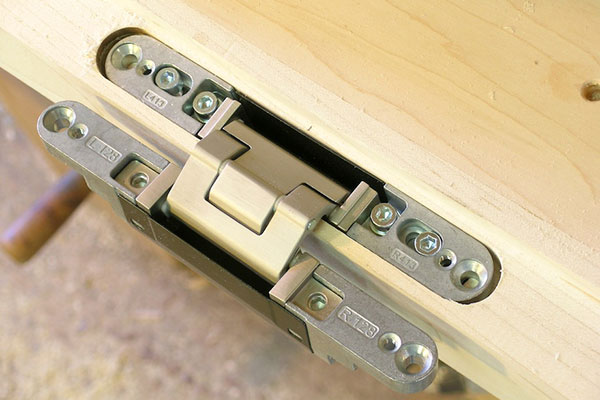
Tectus concealed door hinge. Photo by This is Carpentry
There are many types of hinges and they can be distinguished depending on their location on the door, or on the way they are installed, or the shape they have and the way they work. They all have in common the fact that they are made in metal (there are very rare exceptions) and their basic mechanical principle was summarized, 3 centuries BC, by Archimedes, whit a simple famous sentence: “Give me a place to stand, and I shall move the Earth with it”.
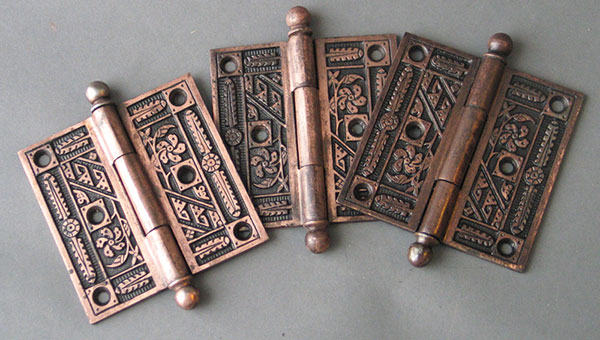
Antique decorative exposed door hinges with copper plating from Historic Houseparts.
The most common type of hinge design is based on the fact that two separate “wings” can rotate around an axis, shaped as a cylinder (barrel), where a pivot is located to ensure the rotation and to keep together the two parts. All the forces are applied to the pivot. This are commonly called barrel hinges.
In relation with their location on the door and how visible they are, you could make a rough subdivision in:
- Visible or fully exposed hinges: when the full hinge is mounted on the leaf and on the frame. This type is not very common in today’s doors but more used in very old doors or in wooden boxes and trunks.
- Butt, mortise hinges: the flat part of the hinges is mounted on the butting surfaces of the doors instead than on the front. In this case, when the door is closed, the two “wings” of the hinge are in contact and only the cylinder is visible. This type is quite common and it is most likely mounted on the door of the room where you are now.
- Invisible hinges: fixed on the side of the door leaf and the frame, they don’t project outside because they are fully recessed in a cavity when the door is closed.
Hinges can have very useful specialized mechanism for specific performances, here just a few:
- Rising hinges allow, in a very simple way, the self-closure of the door, they are very common in toilets and in residential uses in general.
- Swing hinges allow for the leaf to rotate in two directions instead of in one only.
- Projecting hinges allow for the door to open with a full rotation of 180° and be flat against the wall when open.
The limbs: handles.
One of the most “touched” object ever (mobile phones are probably the winners), their shape and functioning is strictly related to the ergonomics.
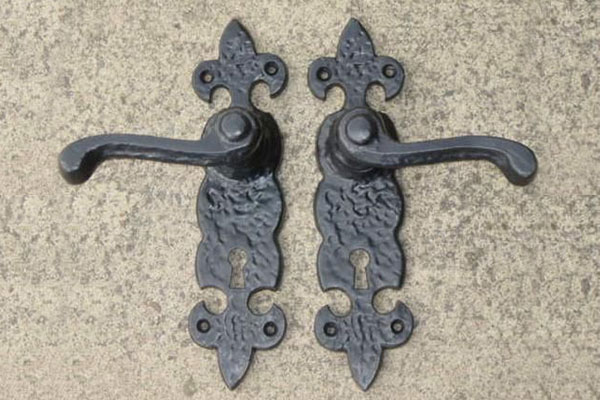
Traditional handles, black antique ironwork latch door handles by Westy Hardware, Yorkshire
The pressure you have to apply to the handle to open the door cannot be too much and it cannot be too little… the diameter and the length of handles have to allow for human hands to grasp them (even if many cats are actually able to use the kitchen handles).. the surfaces have to be smooth enough in order to be comfortable but not too smooth since there is need of a bit of friction to ease the grasp. Handles can also have secondary and not necessarily planned uses: I am sure you hanged at least once your jumper on a handle!
Because of their heavy use handles have to be made in a proper material strong enough and highly cleanable: in specific conditions (hospitals for example) it is advisable to made handle in materials which make very hard for bacteria to survive in their surface (brass is one of them).
The universe of handles is quite vast. I would try to make some very basic distinction not pretending at all to complete the list.
- Pull handles: when there is a door closer or a ball catch for example, then you only have to pull or push to open and close. A pull handle could be used in combination it a push plate placed on the other side and this solution is quite common for WC cubicles.
- Pull handles are very widely used in doors but also in many other objects: drawers, cars, boxes, emergency brakes.
- Lever handles: they require a slightly more complicated sequence of actions compared with pull handles, which can be summarized with three points: to grasp, to rotate and to push (or pull).
- Lever handles can be sprung (the most common ones) or unsprung, but the principle is the same: they operate a retractable triangular latch which slots in a hole (striker plate) to hold the door shut.
- Doors knobs: door knobs can actually fall in the two categories above (pull knobs or turn knobs). Specific knobs with an indicator (busy/free) are very commonly used in public toilets.
There is a wide series of special handles for very specific application: just as examples I would quote panic push or touch handles or handles connected with hermetic enclosures of spaces like fridges or airplanes.
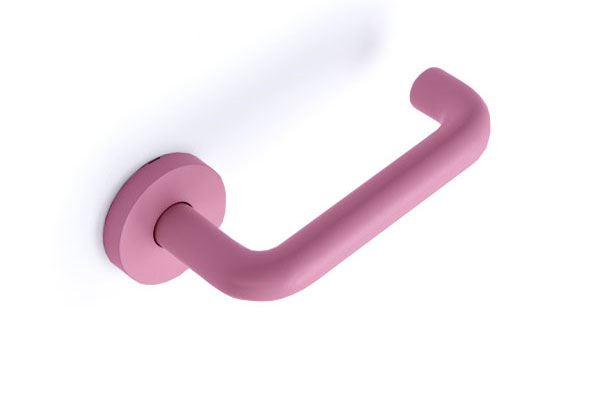
3V 522 Antimicrobial Powder coated lever door handle in JDL Dexo Rose by John Desmond Ltd
The heart: lock
One of the main functions of doors is to select who can, and when, access a specific space: only authorized people can get in. (As a very personal note: in this sense I sometimes wish for a world without doors!) In order to ensure this function you could hire a Colossus to stand in front of the entrance the entire day, but this could result in a quite expensive strategy. Perhaps you could consider fitting a lock instead, as a slightly more practical way to solve the issue.
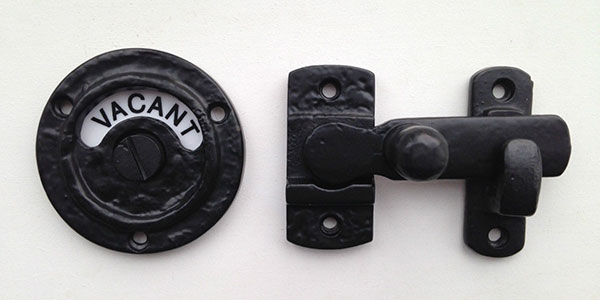
Anachronistic but thoroughly charming Black Antique Iron Vacant Engaged Bathroom WC Toilet Indicator Door Bolt from doorfittings4u
Modern door locks offer different levels of security and their function in a building is very important, to the point that insurance companies can base their decision if cover or not to cover a building, on how strong and secure the locks are.
There are many different types of locks: depending on how they keep the door closed. You could distinguish, for example, dead locks and bolts, which need a key to be operated, from spring bolts, which are kept in position by a spring and need only a handle to be released. Dead bolts are, in very general terms, much more secure than spring bolts and usually the two types are used together in combination.
With ball and magnetic catches a simple pull handle is what you need to open the door and they do not offer a high level of security.
Depending on where and how they are fixed to the door you could identify:
- Rim locks, which are the most ancient ones, mounted on the surface of the leaf. Rim locks are highly visible and easily accessible therefore they are not used, usually, for high security doors.
- Mortise locks are, instead, mounted in a recessed slot within the leaf and non-visible. They usually combine a dead lock operated by a key with a sprung latch operated by a handle. This type is used in many different types of buildings.
There is another very important organ in doors, very small, but quite fundamental in its function.
It stays usually far from the door, always with you, in you handbag or pocket, perhaps hooked to the belt loop, as a symbolic continuous reminder of your connection with the place you call home: the key.